Vietnam is often called one of Southeast Asia’s most beautiful countries, it is easy to see why so many backpackers and travellers are drawn to Vietnam. With pristine sandy beaches, bustling cities and lush rainforest, there is a multitude of potential landmarks waiting to be explored. Here are 20 incredible landmarks you cannot miss when travelling through Vietnam.
Contents
20 Incredible Landmarks in Vietnam
Landmarks in Hanoi
1- Temple of Literature
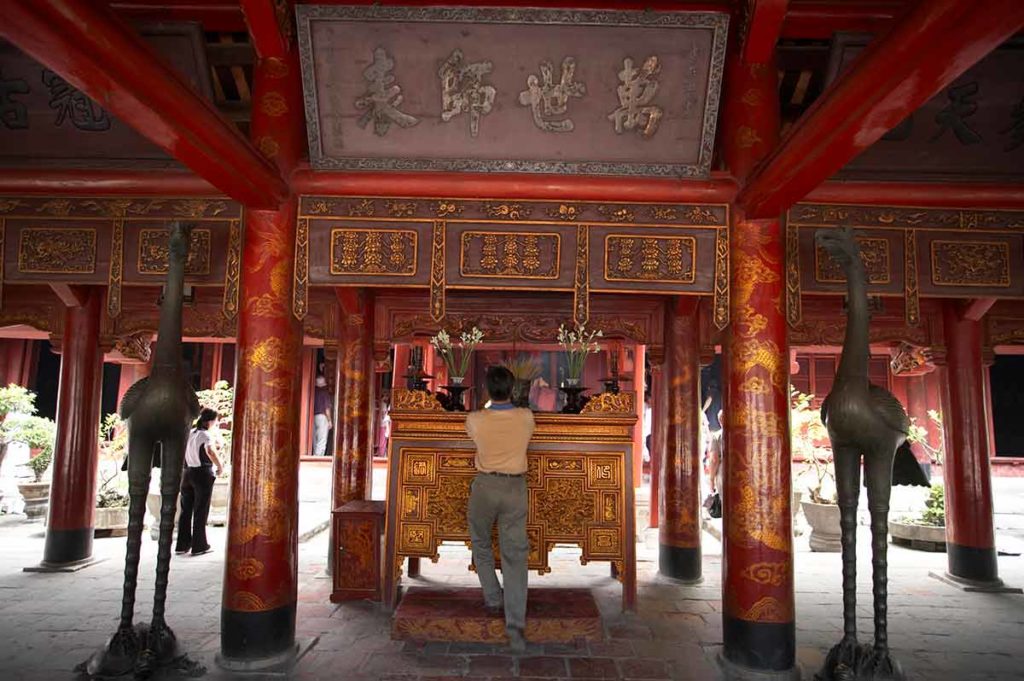
The Temple of Literature is one of the most picturesque landmarks in Hanoi.
What’s unique about this temple is it was originally a university dedicated to the teachings of Confucius in 1070.
Considering its age, the temple is exceptionally well preserved and is a prime example of traditional Vietnamese architecture.
Throughout the grounds are stone carvings of inscriptions from the teachings of Confucius, and ancient trees.
The temple is made up of five courtyards filled with pristine gardens, a large pond known as the Well of Heavenly Clarity, and a large bell and drum tower.
Temple of Literature landmark is at 58 Quoc Tu Giam, Van Mieu, Dong Da, Hanoi.
2- The One Pillar Pagoda
Said to represent a lotus flower growing from the water, the One Pillar Pagoda rises on a single pillar from the centre of a lotus pond.
The pagoda was built in the 11th century and is one of Vietnam’s more spectacular landmarks.
Despite its small size, the pagoda’s shrine is richly decorated and is dedicated to the Vietnamese Buddhist deity Quan Am.
The temple sits atop a single pillar carved into the shape of a lotus blossom, reflecting its surroundings.
The One Pillar Pagoda landmark is at hùa Một Cột, Đội Cấn, Ba Đình, Hà Nội.
More Landmarks in Asia:
Natural Landmarks in Vietnam
3- Hang Sung Sot Cave
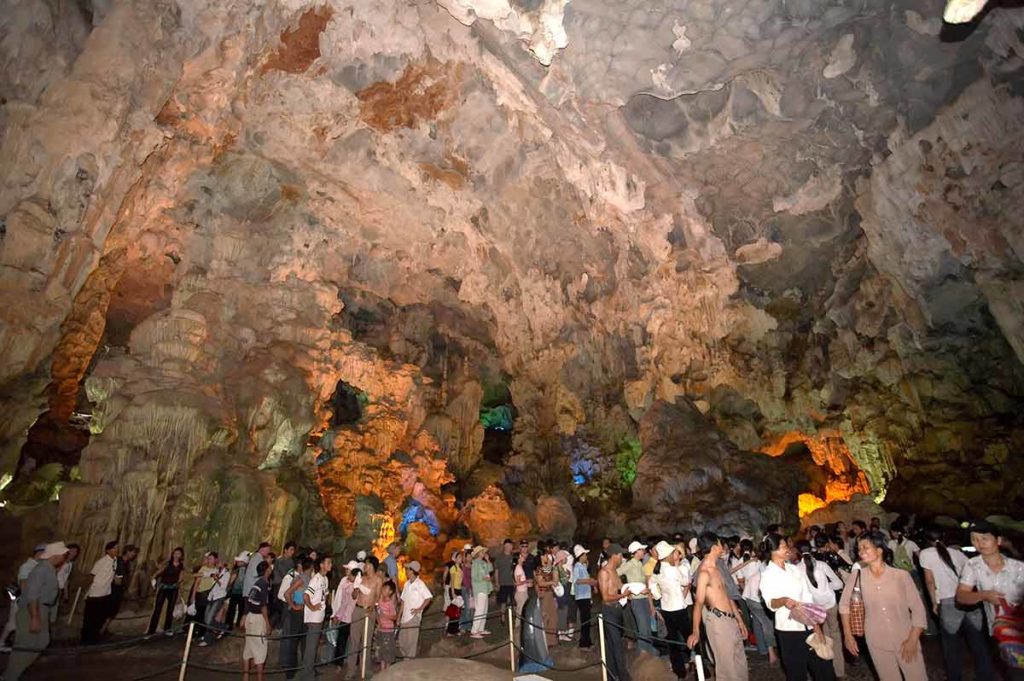
One of the most famous and incredible natural landmarks in Vietnam is Halong Bay, a UNESCO World Heritage Site of 2000 islands, many of which are uninhabited.
A must-visit landmark in Ha Long Bay is Bo Hon Island, home to the staggeringly beautiful Hang Sung Sot Cave or the Cave of Surprises.
The entrance to the cave is a little hike away from the jetty up a steep path.
Once inside the cave you are met with unusual rock formations, including a tortoise and a Buddha.
The caves are illuminated with colourful lights, and with pools of water dotted around, it makes for a magical experience.
Hang Sung Sot Cave landmark is at Bo Hon Island, Ha Long Bay, Halong City, Quảng Ninh.
4- Hang Son Doong
Deep within the Phong Nha-Kẻ Bàng National Park is Hang Sơn Đoòng, one of the most incredible cave systems in the world.
The cave’s name translates to Mountain River Cave and is still expanding in size due to an underwater tunnel which connects to another cave.
The cave is immensely large, 200 meters high and 9.4km long, and is home to monkeys, snakes and flying foxes.
When visiting the cave, two dolines or sinkholes illuminate previously dark areas with light, exposing an internal jungle with trees as tall as 50 metres.
The worlds largest stalagmites can also be found here.
Hang Sơn Đoòng landmark is at Xuân Trạch, Bố Trạch District, Quang Binh Province.
5- Ban Gioc Waterfalls
Fed by the Quay Son River, which marks the border with China, Ban Gioc Waterfalls are an incredible landmark in Vietnam.
The waterfall is 30 m high and 300 m wide, making it the widest waterfall in Vietnam.
The falls drop three times into a pool of shimmering blue water below and are surrounded by lush jungle.
The falls can be viewed from afar, however, it is worth the low entrance fee and raft hire to get a closer feel of the falls.
Locals punt you down the river on bamboo rafts to get visitors as close to the falls as possible.
Ban Gioc Waterfall landmark is at TL 211, Đàm Thuỷ, Trùng Khánh, Cao Bằng.
6- Cat Dua
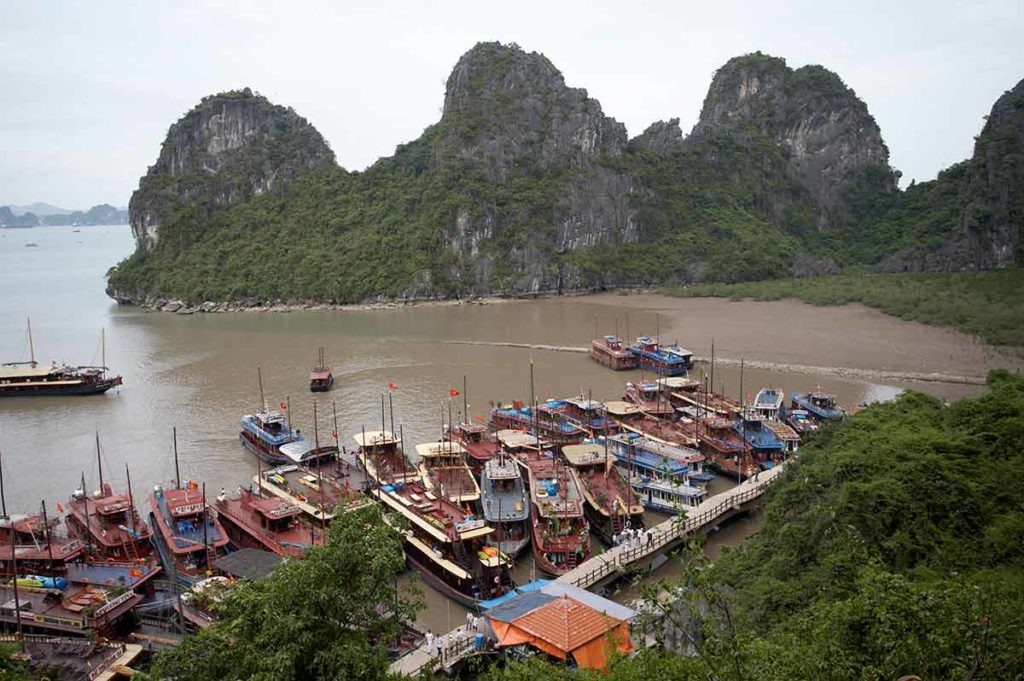
In the spectacular Halong Bay Area, a UNESCO World Heritage Site translating to ‘the Bay of Descending Dragons’, is Cat Dua, a spectacularly beautiful island only accessible by boat.
The island has white sand beaches and crystal clear blue waters lapping gently at the shore.
The island is popular with water sports enthusiasts as kayaking and snorkelling are available here.
The island has more to it than water sports, however.
In English, the name translates to Monkey Island, as this is where hundreds of monkeys who inhabit the island hang around the beach to interact with locals and tourists.
Cat Dua landmark is at Monkey Island, Lan Ha Bay, Cat Ba Island.
7- Mui Ne Sand Dunes
Mui Ne is a tiny fishing village on the Eastern coast of Vietnam.
The village is popular with visitors for its beaches, local charm, cuisine and stunning scenery, however, it is the dunes here that make it a must-see landmark.
Towering over a calm blue lotus pond is the white sand dune of Mui Ne.
The dunes form an unusual site next to the pond surrounded by lush green rainforest.
The dunes are an accessible location for quad biking, and many locals offer a rental service allowing visitors to ride over the mounds of sand.
Mui Ne Sand Dunes landmark is at Hoa Thang, Bac Binh, Mui Ne, Phan Thiet.
8- Titop Island
A longstanding must-see landmark of Vietnam is Titop Island.
Named after Russian cosmonaut Gherman Titov who visited Halong Bay where the island lies in 1962, this tower of limestone and rainforest is a spectacular sight.
One of the smaller islands in the bay, Titop welcomes visitors with white sand beaches synonymous with this area, as well as snorkelling warm, calm waters.
The island is popular with water sports, but its most prominent attraction is at its summit.
After a climb of 427 steps through the rainforest that covers the island, visitors are rewarded with a mountaintop gazebo and breathtaking views over the surrounding bay.
Titop Island landmark is at Titop Island, Halong Bay.
For more amazing European Landmarks, read:
- 30 Spain Landmarks
- 20 Switzerland Landmarks
- 22 Germany Landmarks
- 35 London Landmarks
- 30 France Landmarks
- 20 Italy Landmarks
- 20 Greece Landmarks
- 20 Russia Landmarks
- 20 Scotland Landmarks
- 20 Ireland Landmarks
- 21 Wales Landmarks
- 20 Turkey Landmarks
- 20 England Landmarks
- 20 Hungary Landmarks
- 21 Romania Landmarks
- 20 Ukraine Landmarks
- 20 Athens Landmarks
- 20 Rome Landmarks
- 20 England Landmarks
- 20 Portugal Landmarks
- 20 Poland Landmarks
- 20 Iceland Landmarks
- 20 Bulgaria Landmarks
- 21 Croatia Landmarks
- 20 Bulgaria Landmarks
- 20 Austria Landmarks
- 21 Finland Landmarks
- 20 Sweden Landmarks
- 20 Denmark Landmarks
- 20 Belgium Landmarks
- 20 Netherlands Landmarks
- 20 Barcelona Landmarks
- 21 Czech Republic Landmarks
- 20 Landmarks in Paris
- 20 Landmarks in Liverpool
- 10 Istanbul Landmarks
Historic Landmarks in Vietnam
9- Cavern Pagoda
The Mekong Delta is where the Mekong River meets a series of tributaries, stretching over 15000 square miles.
This area is called Cuu Long, meaning Nine Dragons, as nine tributaries are leading from this area.
While visiting the Mekong Delta, venture off the river to Sam Mountain.
Located partway up Sam Mountain, the Cavern Pagoda can be found. Phuoc Dien Tu, as it is known locally, is a red brick pagoda surrounded by lush gardens.
The lower pagoda holds the monk’s quarters and tombs, while the upper pagoda houses many caves filled with statues of Buddha and other deities.
Cavern Pagoda landmark is at QL91, Xã Vĩnh Tế, Thị Xã, Châu Đốc, An Giang.
10- Golden Bridge

Held aloft by two giant stone hands is the Golden Bridge, which is a new landmark in Vietnam opened in June 2018.
The hands appear to emerge from the hillside itself, gently supporting the golden-coloured bridge and walkway.
The hands look ancient, and as though they were carved from stone.
They were constructed using steel meshes, fibreglass and finishing design detailing to give the impression that the hands have stood on this hillside for thousands of years.
The bridge is suspended 1400 metres above sea level offering breathtaking views over the mountains and jungles surrounding it.
Golden Bridge landmark is at Sun World Bà Nà Hill, Hoà Phú, Hòa Vang, Đà Nẵng.
11- Su Muon Pagoda
The island of Phu Quoc is covered by pristine white sand beaches, incredible forests of the national park, and local fishing villages.
It is, however, the islands pagoda’s that set it apart as a must-see landmark in Vietnam.
Sitting atop a hill around four kilometres from Duong Dong Town is Su Muon Pagoda, the oldest Buddhist shrine on the island.
It was founded in 1932 by a local monk named Nguyen Kim Muon.
The pagoda features extremely colourful statues of Buddha and other deities, as well as rock formations painted to depict animals.
Within the grounds stands a 300-year-old Keina tree which adds to the peace and tranquillity of the pagoda.
Su Muon Pagoda landmark is at Dương Tơ, Phú Quốc, Kien Giang.
12- My Son Sanctuary
My Son Sanctuary sits on the mountainous border of Duy Xuyen District in Central Vietnam.
The sanctuary dates from the 4th to the 13th centuries, with architectural additions continually being added and developed.
The sanctuary is surrounded by tropical jungle, and its Hindu-themed ruins range from delicate stone sculptures and temples to ornately carved towers.
Over the centuries, the sanctuary fell into disrepair and neglect and was sadly bombed by the Americans during the Vietnam War.
Much of the site, however, remained intact and some areas have been rebuilt.
My Son Sanctuary landmark is at Thôn, Mỹ Sơn, Duy Xuyên, Quảng Nam.
13- Dao Tien Endangered Primate Species Centre
On a small isolated island in the Cat Tien National Park is the Dao Tien Endangered Primate Species Centre.
Within the centre, endangered species such as golden-cheeked gibbons, silver langur and pygmy loris are cared for and taught vital survival skills before being released back into the wild.
Many of the primates in the care of the centre were pets through the illegal trade of exotic animals, and need to be retaught basic skills to survive.
Native fruit trees have been planted on the island to encourage the primates natural foraging skills as part of their rehabilitation.
Visitors can view these primates in their semi-wild environment, and can even sponsor individual primates to support their rehabilitation and care.
Dao Tien Endangered Primate Species Centre landmark is at Dong Nai, Đạ Tẻh District, Lâm Đồng.
14- Thien Mu Pagoda
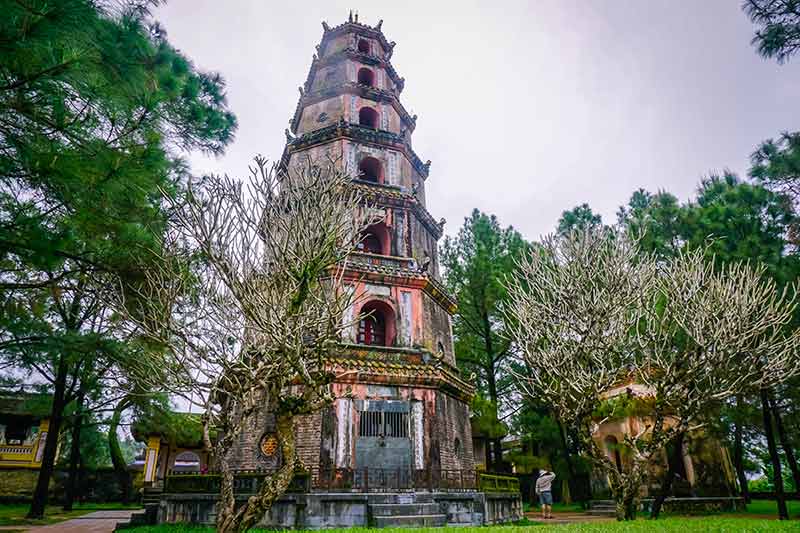
A symbol in many romantic poems and lyrical songs, Thien Mu Pagoda, or the Pagoda of the Celestial Lady is one of Hue’s most ancient pagodas.
The pagoda was built in 1601, with an extensive restoration carried out in 1714.
Following its reconstruction, the pagoda gained the reputation of the most beautiful pagoda in the Ancient City.
The most symbolic part of Thien Mu Pagoda is the Phuoc Duyen Tower, a beautiful ornate octagonal tower with seven floors, representing the sacred number in Vietnam Buddhism.
A spiral staircase leads visitors to the sixth floor, and a separate ladder and locked door gain entry to the seventh.
Atop the seventh floor is a golden Buddha statue.
Thien Mu Pagoda landmark is at Hương Hòa, Thành phố Huế, Hương Hòa Thành phố Huế Thừa Thiên Huế.
15- Tomb of Khai Dinh
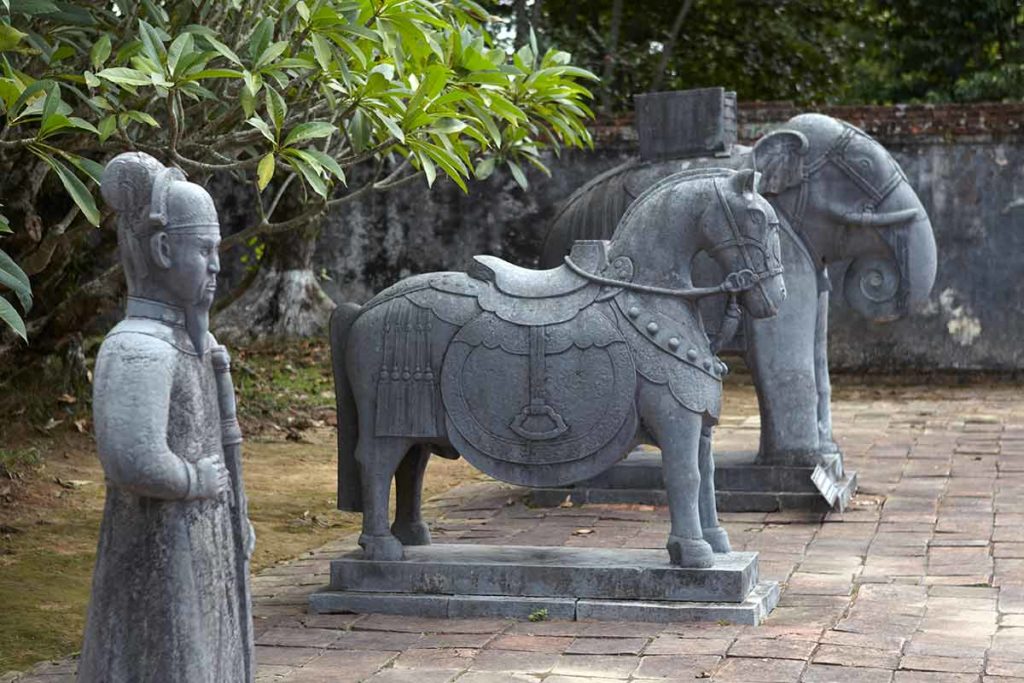
Made from dark and weathered concrete and sitting on a hillside is the Tomb of Khai Dinh, the penultimate emperor of Vietnam from 1916 to 1925.
The tomb is extravagantly decorated inside and out, with stone dragons and elephants, and warriors guarding the entrance.
Each structure features ornate carvings and columns.
Inside Thien Dinh, the main structure, are elegant murals featuring the four seasons and the Eight Immortals.
The concrete canopy is speckled with gold. Beneath this canopy is a gilt bronze statue of Khai Dinh, with his remains buried below the statue.
Tomb of Khai Dinh landmark is at Khải Định, Thủy Bằng, Hương Thủy, Thừa Thiên Huế.
16- An Hien Garden House
Hue as a city is filled with many impressive pagodas, mausoleums and garden houses.
There are non however like An Hien Garden House, an unmissable landmark when visiting Hue.
The house was constructed in the late 19th century for the 18th daughter of Duc Duc emperor.
The gardens feature entwined apricot trees, large rectangular ponds filled with water lilies and plants which grow throughout all four seasons.
This garden house is also filled with many fruit trees, including durian, jackfruit and dragon fruits.
Inside the house, many features are made from wood from the gardens fruit trees, including a truss system made from jackfruit wood.
An Hien Garden House landmark is at 68 Nguyen Phuc Nguyen Street, Xuan Hoa Village, Huong Long Commune, Hue City.
17- Hue Imperial City
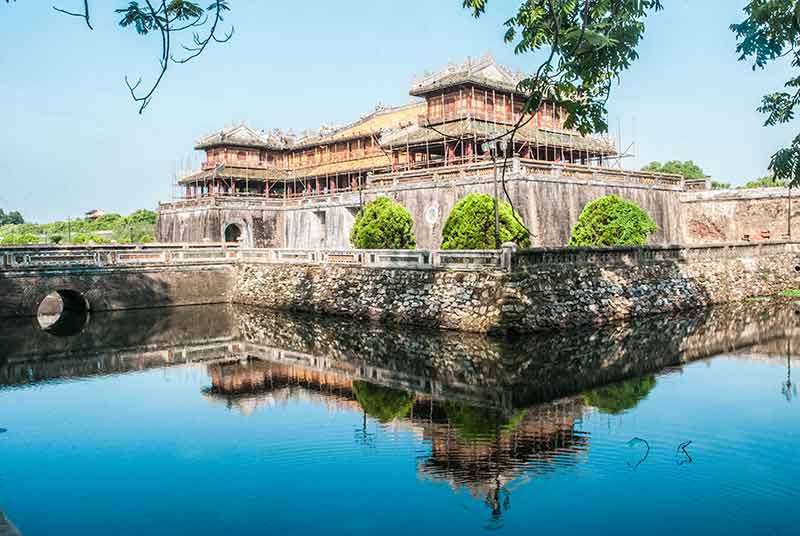
In the 19th century, Emperor Gia Long wanted a citadel in the style of Beijing’s Forbidden City to be built in Vietnam.
A site in Hue was chosen and work began at the start of the century.
The citadel was added to and expanded over the reigns of many Emperors but was sadly heavily damaged during the Vietnam war when America bombed vast areas of Hue.
The city is now a UNESCO site and the buildings that are still standing have been carefully restored.
The Imperial Citadel has recently been restored and can be entered by walking through the imposing and intricately carved and decorated city gates.
Hue Imperial City landmark is at Thành phố Huế, Thua Thien Hue.
18- Japanese Covered Bridge
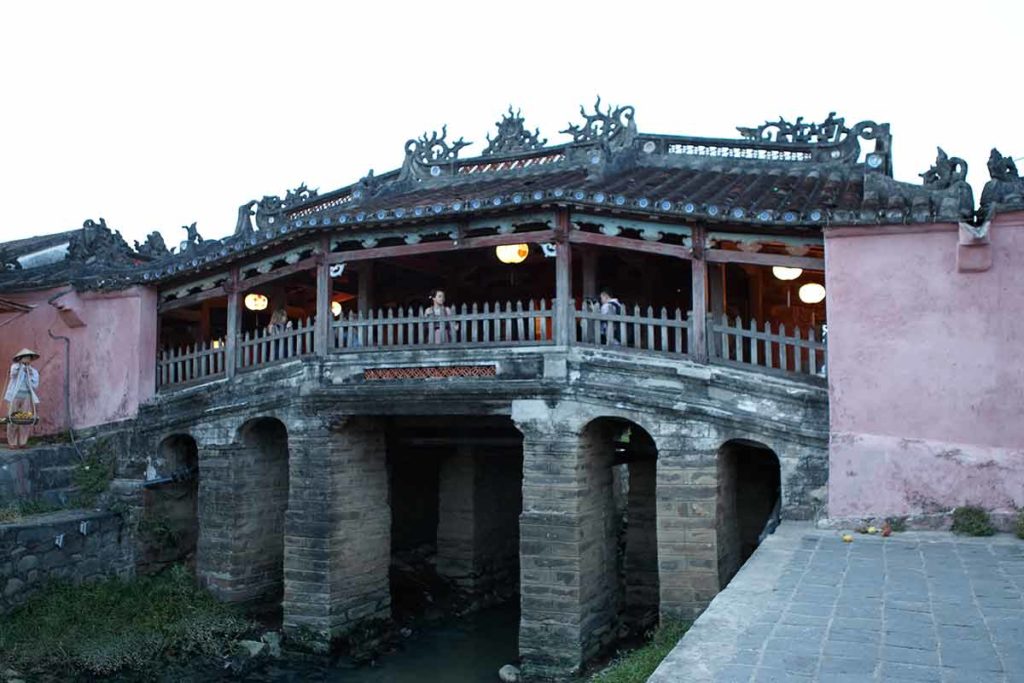
When visiting historical sites in the city of Hoi An, the Japanese Covered Bridge is a landmark you cannot miss.
The bridge crosses a river between two bustling markets that often run late into the night.
The architecture of the bridge is spectacular.
Built in the 17th century, the bridge is made from deep red brick and decorated with ornate carvings and a pagoda-style roof.
The carvings depict animals and nature.
Over the last 400 years, the bridge has been carefully preserved and restored where necessary.
Japanese Covered Bridge landmark is at Nguyễn Thị Minh Khai, Phường Minh An, Hội An, Quảng Nam.
For more things to do in Vietnam, read:
- 20 Things To Do In Ho Chi Minh City
- 15 Things To Do In Hanoi
- 15 Things To Do In Hoi An
- Things To Do In Hue
- Vung Tau Travel Guide
- Vietnam River Cruise
- Hanoi vs Ho Chi Minh City
- 20 Beaches In Vietnam
- 20 Vietnam Cities
- Where To Stay In Hanoi
- Where To Stay In Ho Chi Minh City
- Where To Stay In Hoi An
- 20 Things To Do In Phu Quoc
- 20 Things To Do In Nha Trang
- 20 Islands In Vietnam
- 20 Things To Do In Danang
- 20 Things To Do In Dalat
- 20 Things To Do In Sapa
- Everything You Need To Know About Living In Vietnam
- 15 Things Vietnam Is Famous For
- 20 Beachfront Villas and Overwater Bungalows in Vietnam
19- Cu Chi Tunnels
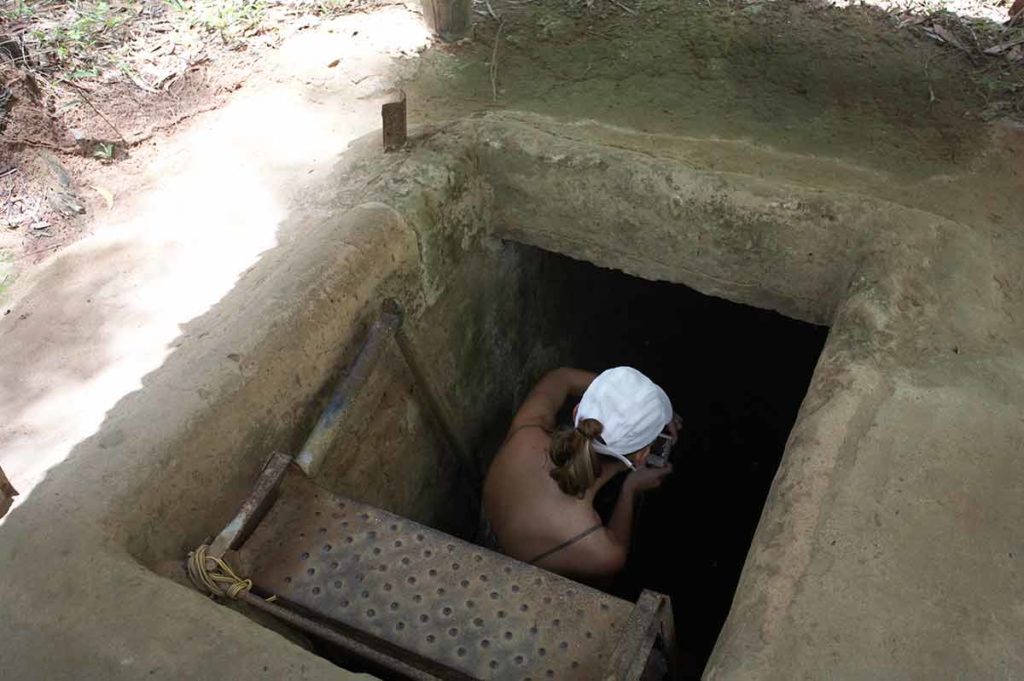
A necessary element of the Viet Cong war effort, the Cu Chi Tunnels were part of a network of tunnels, allowing troops to have underground routes to transport communications and supplies, as well as house troops.
As the war progressed, the tunnels grew to house entire villages underground, safely away from the bombings above.
Life resumed as normally as possible here, and there were even theatres and music halls built to entertain troops and civilians.
Visitors to the tunnels today can crawl through safe areas of the tunnel network and view command centres, booby traps and firing ranges, as well as eating a typical meal eaten by soldiers living in the tunnels.
Cu Chi Tunnels landmark is at L15, Phú Hiệp, Củ Chi, Hồ Chí Minh.
20- Phuoc Lam Pagoda
Associated with a 17th-century child prodigy and monk, Phuoc Lam Pagoda lies in Hoi An town.
The pagoda was built in an ancient Asian architectural style and is formed from three chambers, two lean-twos and two bell towers.
Inside the pagoda are guilt statues of Buddha, dark hardwood carvings and deep grey marble floors.
The pagoda is still actively used today by monks, who dress in bright orange robes.
The pagoda features a red roof with blue edging, and pillars are ornately decorated with carved dragons.
Phuoc Lam Pagoda landmark is at Le Hong Phong Cam Ha, Hoi An.
Also read:
- 20 USA Landmarks
- 23 Canada Landmarks
- 22 Ohio Landmarks
- 21 Arizona Landmarks
- 21 Minnesota Landmarks
- 21 Oregon Landmarks
- 21 Illinois Landmarks
- 21 Colorado Landmarks
- 21 Georgia Landmarks
- 21 Michigan Landmarks
- 23 Los Angeles Landmarks
- 21 Washington Landmarks
- 21 Maryland Landmarks
- 20 Manitoba Landmarks
- 20 Kansas Landmarks
- 21 New Mexico Landmarks
- 20 Idaho Landmarks
- 20 Montana Landmarks
- 20 Oklahoma Landmarks
- 21 Wisconsin Landmarks
- 20 Tennessee Landmarks
- 21 Iowa Landmarks
- 20 Alaska Landmarks
- 20 Miami Landmarks
- 21 West Virginia Landmarks
- 21 Kentucky Landmarks
- 20 Louisiana Landmarks
- 21 Arkansas Landmarks
- 20 Cincinnati Landmarks
- 20 San Antonio Landmarks
- 25 Indiana Landmarks
- 21 New York Landmarks
- 20 Texas Landmarks
- 21 Boston Landmarks
- 20 Florida Landmarks
- 20 Hawaii Landmarks
- 5 South Dakota Landmarks
- 21 Pennsylvania Landmarks
- 23 New Jersey Landmarks
- 21 Virginia Landmarks
- 21 North Carolina Landmarks
- 21 Utah Landmarks
- 21 Nevada Landmarks
- 20 Massachusetts Landmarks
- 20 Washington DC Landmarks
- 20 Vermont Landmarks
- 20 Nebraska Landmarks
- 20 North Dakota Landmarks
- 21 Missouri Landmarks
- 20 Rhode Island Landmarks
- 21 Maine Landmarks
- 21 Connecticut Landmarks
- 20 San Diego Landmarks
- 20 Landmarks In South Carolina
- 20 Mississippi Landmarks
- 20 Las Vegas Landmarks
- 20 Dallas Landmarks
- 20 Houston Landmarks
- 20 Seattle Landmarks
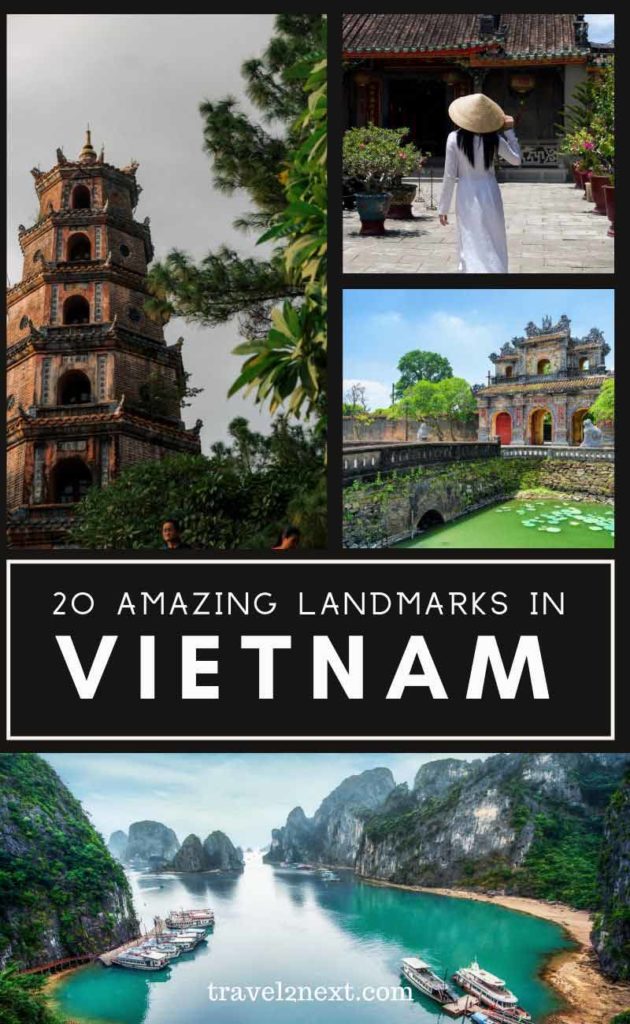
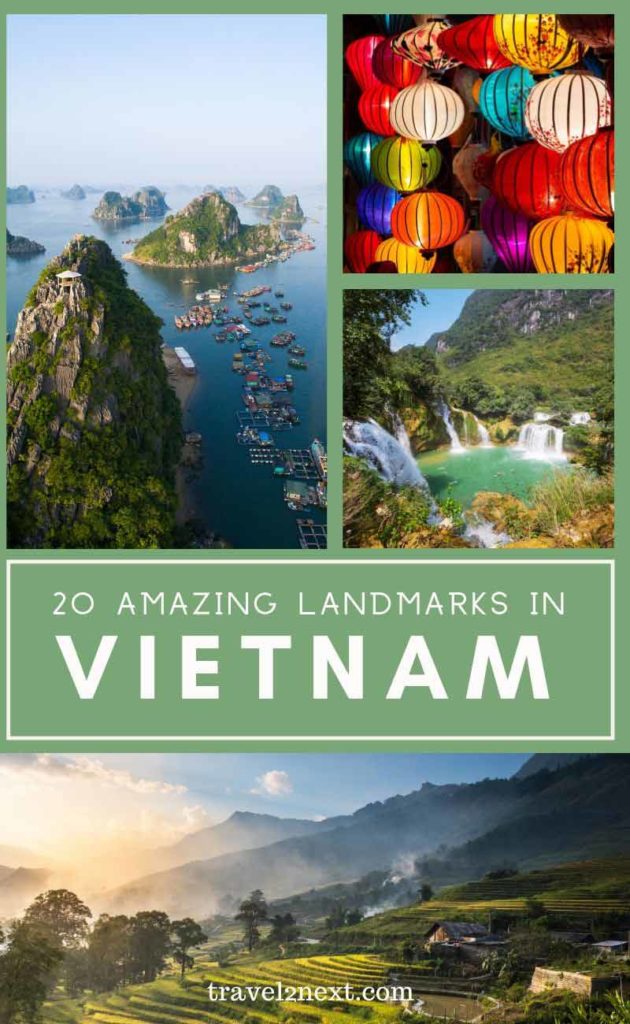
Plan Your Trip

Rent A Car – Find the best car rental rates at Discover Cars. They compare car hire companies to provide you with the best deal right now.

Find A Hotel – If you’re curious about this article and are looking for somewhere to stay, take a look at these amazing hotels.

